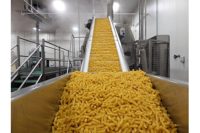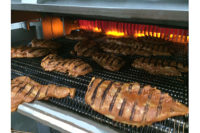Perfect Pasta Picks the Perfect Cooking, Cooling Equipment
Continuous flow pasta cooking, cooling equipment helps Perfect Pasta, Inc. live up to its name.

Although the availability of meals on U.S. airlines has changed considerably over the past few years, business and first-class flyers and those on international flights still receive in-flight meals as part of their ticket price, and a variety of dining options are usually provided.
For meals containing steak or chicken, the on-ground food preparation cycle of cooking, cooling and packaging the entrée to achieve a delicious meal is a fairly straight-forward process. But pasta dishes are significantly more difficult to prepare on-ground and yet end up with an on-board dish that has the texture and taste of authentic Italian cuisine – one that will not only satisfy the typical business or first-class passenger but will also please the most discerning traveling connoisseur.
The challenge of in-flight pasta dishes
The difficulty lies in the pasta cooking and cooling process. There are many different types of pasta, each requiring varied cooking times. For pasta entrées, such as in-flight meals that will be frozen, the pasta is only partially cooked (blanched), and needs to be cooled very rapidly to stop the cooking process. Otherwise, when the pasta is reheated onboard it will be too stiff or too soft, instead of al dente, which is the desired texture of cooked pasta in traditional Italian cooking.
Kettle systems or Italian conveyor systems have been used for quite some time to cook and blanch pasta, but they have their drawbacks. Neither is capable of precisely controlling the temperature and time of the pasta cooking and cooling process. And, equally important is their difficulty in keeping the long pastas like fettuccine, linguine, tagliatelle and spaghetti from sticking together during the blanching and cooling process. Neither system provides an agitation capability to keep the pasta strands separated.
The sticking develops clumps of pasta which need to be removed and increases waste. Hence, the long pastas, even though consumer interest in them has been steadily growing, have proven to be more costly to produce and run a higher risk of being a lesser quality Italian dish when served.
Perfect Pasta, Inc.
One maker of pasta entrées for airline in-flight meals has successfully surmounted this problem. Perfect Pasta, Inc., based outside of Chicago, produces 250,000 pasta entrées each month for in-flight meals. The company is all about pasta – it produces several hundred different varieties of freshly made pasta products that can be custom created for its clients, which includes many of the airlines.
Its pasta products include such dishes as Roasted Red Pepper Stuffed Gnocchi, Asparagus Filled Striped Agnolotti, Jumbo Roasted Butternut Squash Ravioli, Eight Finger Cavatelli and Cheese and Spinach Filled Rotollo, not to mention supplying a complete array of long pastas like fettuccini, linguini, and angel hair. All of its pastas are made with 100 percent semolina, with no artificial colorants, food additives or preservatives. To bring out unique flavors, the company infuses its hand-made doughs with finely ground spinach, tomatoes, lemon pepper, carrots, parsley, squid ink and many other fresh herbs to enhance the flavor of its pastas naturally.
And, they offer 60 to 70 different fillings for their pastas. Perfect Pasta also makes risotto, and Italian beef and sausage.
Perfect Pasta is the largest supplier of in-flight pasta meals to the airline industry, representing 30 percent of the company’s total annual sales. “If you are eating a pasta entrée on an overseas flight or on a first-class flight in the U.S., then you are most likely eating one produced by us,” says Mario Demarco, president of Perfect Pasta.
Another 30 percent of its business is supplying fresh pasta and pasta dishes to high-end restaurants throughout the Midwestern states, and 40 percent of its business is supplying bulk pasta products to the foodservice industry and private labeling.
What has made this company so successful with such a finicky product as freshly cooked pasta? It has mastered the art of combining traditional Italian pasta-making techniques with the latest highly-automated, continuous cooking-cooling process technology, enabling the company to produce the finest quality, authentic Italian fresh pasta – including the long pastas – on a mass scale. Perfect Pasta’s 45,000-square-foot plant can produce up to 5,000 pounds of fully-cooked and prepared pasta meals per hour.
Continuous-flow pasta cooking and cooling
The continuous-flow pasta cooking/cooling system which Perfect Pasta uses was developed by Lyco Manufacturing. The cooker-coolers utilize two completely enclosed duo rotary drum cylinders, one for cooking and one for cooling directly following in sequence. The drums have internal augers – a perforated skin sheet is wrapped around the drums and fixed to the auger’s flights. These flights gently move the pasta through the cooker and cooler system. The pasta is carefully agitated, while submersed in water, as it advances through the cylinders. Damage to fragile pasta products is a fraction of one percent.
Once through the cooker machine, having reached the programmed temperature/time – in a first-in/first-out sequence – the pasta is then gently deposited into the following cooling drum, and chilled to its programmed temperature/time factor. The pasta is then released onto a belt conveyor for downstream combining with sauce, vegetables and other ingredients. The entrées are sealed and then move into a spiral freezer where they are individually quick frozen (IQF) at -45F, boxed and put into cold storage at -10F to be subsequently shipped to the airlines.
Consistent process parameters for temperature, time and recipes automatically controls the pasta cooking and cooling hour after hour, and completely out-performs the batch method and the Italian cooker formally used by Perfect Pasta.
Having a truly continuous process for cooking and cooling pasta, and the flexibility of running multiple products throughout the production day at different temperatures and at different retention times is a unique feature that Lyco equipment provides.
Improved process control
“We are processing 500,000 pounds of pasta output per month through the cooker-cooler, an average of 20,000 pounds per day,” continues Demarco. “The consistency of the pasta is excellent, and there is no clumping together. It is like cooking fresh pasta in a pot at your home. That’s how good this system is. The pasta floats in the water, and we can cook it anywhere from 3 minutes to 24 minutes at 206 to 207F, depending on what item we are making. The Italian cooker does not allow that degree of latitude. The time and temperature is precisely monitored, and everything is charted, so we can also see the continuous temperature over time.”
“The cooler unit runs at 50 to 60F, which stops the pasta from cooking right away,” explains Demarco. “This improves the consistency and gives a better quality pasta than what we have had with other systems. We also process about 2,000 pounds of rice a day through the cooker-cooler. The consistency of the rice is beautiful, the way I want it – a little bit of texture, al dente style. We put a cream in it and make risotto. Just like in Italy. Bellissimo!”
(920) 623-415 / www.lycomfg.com
Jim McMahon writes on emerging technologies in food processing. He may be reached at jim.mcmahon@zebracom.net
Looking for a reprint of this article?
From high-res PDFs to custom plaques, order your copy today!




